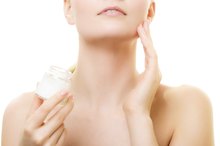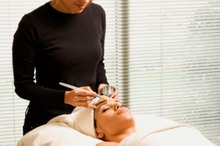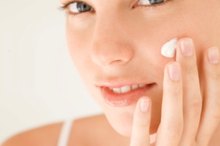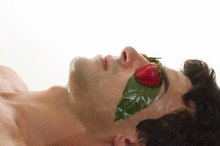Glycolic Acid & Dark Skin
Glycolic acid is a type of alpha hydroxy acid derived from sugarcane. An all-natural, water-soluble chemical exfoliant, it is commonly found in topical cosmetic products for aging, sun damaged and acne-prone skin. Glycolic acid is generally considered safe for dark skin and is often used to diminish the signs of hyperpigmentation, a harmless condition characterized by dark, discolored patches of skin.
Background
Hyperpigmentation occurs when over-stimulated or damaged cells make too much melanin, the chemical that determines skin color. A number of factors trigger this condition, including hormones, sun exposure and injury to the skin caused by burns, scratches and acne. Though hyperpigmentation can affect men and women of all races, people of color are most susceptible.
- Hyperpigmentation occurs when over-stimulated or damaged cells make too much melanin, the chemical that determines skin color.
- Though hyperpigmentation can affect men and women of all races, people of color are most susceptible.
Glycolic Acid Benefits
Aha Vs. Bha
Learn More
Glycolic acid is available in several cosmetic preparations, from over-the-counter lotions to medical-grade superficial facial peels 4. The chemical works to rejuvenate skin by penetrating the uppermost layer of the epidermis. There, it helps break apart the dead, damaged cells for easier removal and exposes the healthier layer of skin beneath. Glycolic acid can help fade the effects of hyperpigmentation by gradually peeling away dark marks and scars.
- Glycolic acid is available in several cosmetic preparations, from over-the-counter lotions to medical-grade superficial facial peels 4.
- Glycolic acid can help fade the effects of hyperpigmentation by gradually peeling away dark marks and scars.
Over-the-Counter Preparations
Over-the-counter glycolic acid products are available in 5 to 20 percent concentrations. Products include face washes, lotions and serums, which are formulated for frequent self-application. People usually see results within a few months, according to Dr. Susan Taylor, author of “Brown Skin. 3”
- Over-the-counter glycolic acid products are available in 5 to 20 percent concentrations.
- People usually see results within a few months, according to Dr. Susan Taylor, author of “Brown Skin.
Chemical Peels
Does Kojic Acid Cause Acne?
Learn More
Glycolic acid peels for hyperpigmentation are given as a series of four to six treatments, each one spaced about a month apart 14. Peels range in strength from 20 to 70 percent. Due to the higher concentration of acid, chemical peels have the potential to further damage skin. Only a doctor or qualified aesthetician should perform chemical peels.
- Glycolic acid peels for hyperpigmentation are given as a series of four to six treatments, each one spaced about a month apart 1.
Considerations
Glycolic acid is tolerated well by darker pigmented skins, especially when the treatment strength is gradually increased over time, according to “Glycolic Acid Peels,” by Ronald L. Moy 4. However, glycolic acid is not for everyone. While common side effects include temporary stinging, redness and mild irritation, more severe reactions can result in scarring and even worse hyperpigmentation. As with all medicines, consult a professional before use.
- Glycolic acid is tolerated well by darker pigmented skins, especially when the treatment strength is gradually increased over time, according to “Glycolic Acid Peels,” by Ronald L. Moy 4.
Related Articles
References
- BrownSkin.net: Hyperpigmentation Treatments
- Aesthetics and Cosmetic Surgery for Darker Skin Types; Pearl E. Grimes
- Brown Skin; Susan C. Taylor M.D.
- Glycolic Acid Peels; Ronald L. Moy et al.
- National Institutes of Health PubChem. Glycolic acid. Updated February 1, 2020.
- Tang SC, Yang JH. Dual effects of alpha-hydroxy acids on the skin. Molecules. 2018;23(4):863. doi:10.3390/molecules23040863
- Fabbrocini G, Annunziata MC, D'Arco V, et al. Acne scars: pathogenesis, classification and treatment. Dermatol Res Pract. 2010;2010:893080. doi:10.1155/2010/893080
- U.S. Food and Drug Administration. Alpha hydroxy acids. Updated May 7, 2019.
- Al-Talib H, Al-Khateeb A, Hameed A, Murugaiah C. Efficacy and safety of superficial chemical peeling in treatment of active acne vulgaris. An Bras Dermatol. 2017;92(2):212–216. doi:10.1590/abd1806-4841.20175273
- Abels C, Reich H, Knie U, Werdier D, Lemmnitz G. Significant improvement in mild acne following a twice daily application for 6 weeks of an acidic cleansing product (pH 4). Journal of Cosmetic Dermatology. 2014;13(2):103-8. doi:0.1111/jocd.12086
- Kaminaka C, Uede M, Matsunaka H, Furukawa F, Yamomoto Y. Clinical evaluation of glycolic acid chemical peeling in patients with acne vulgaris: a randomized, double-blind, placebo-controlled, split-face comparative study. Dermatological Surgery. 2014;40(3):314-22. doi:10.1111/dsu.12417
- Sharad J. Glycolic acid peel therapy - a current review. Clinical Cosmetic and Investigational Dermatology. 2013;6:281-8. doi:10.2147/CCID.S34029
- Takenaka Y, Hayashi N, Takeda M, Ashikaga S, Kawashima M. Glycolic acid chemical peeling improves inflammatory acne eruptions through its inhibitory and bactericidal effects on Propionibacterium acnes. Journal of Dermatology. 2012;39(4):350-4. doi:10.1111/j.1346-8138.2011.01321.x
Writer Bio
Julia Estrela has been working as a freelance writer since 2008. Her work has appeared in various online publications. Estrela holds a Bachelor of Arts in English with a concentration in creative writing from Connecticut College.









